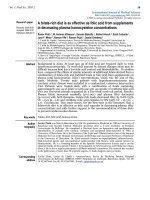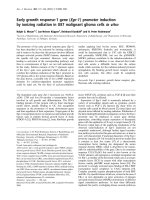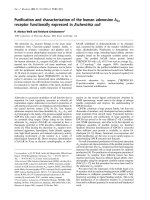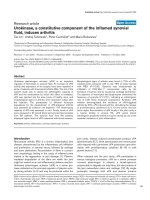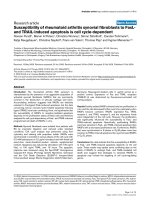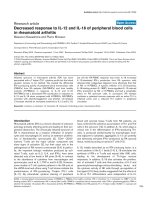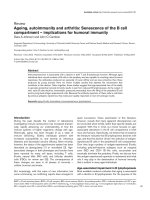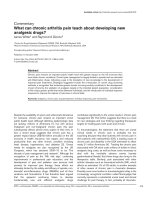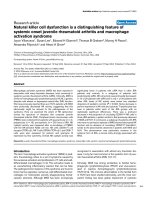Báo cáo y học: "Early onset pauciarticular arthritis is the major risk factor for naproxen-induced pseudoporphyria in juvenile idiopathic arthritis" pdf
Bạn đang xem bản rút gọn của tài liệu. Xem và tải ngay bản đầy đủ của tài liệu tại đây (390.37 KB, 8 trang )
Open Access
Available online />Page 1 of 8
(page number not for citation purposes)
Vol 9 No 1
Research article
Early onset pauciarticular arthritis is the major risk factor for
naproxen-induced pseudoporphyria in juvenile idiopathic arthritis
Susanne G Schäd
1,2
, Andrea Kraus
3
, Imme Haubitz
4
, Jiri Trcka
1,2
, Henning Hamm
1
and
Hermann J Girschick
3
1
Department of Dermatology, Venereology and Allergology, University of Würzburg, Josef-Schneider-Str, 97080 Würzburg, Germany
2
Department of Dermatology and Venereology, University of Rostock, Augustenstr, 18055 Rostock, Germany
3
Department of Pediatrics, Section of Pediatric Rheumatology and Osteology, University of Würzburg, Josef Schneider Str, 97080 Würzburg,
Germany
4
IT Centre, University of Würzburg, Am Hubland, 97074 Würzburg, Germany
Corresponding author: Susanne G Schäd,
Received: 11 Oct 2006 Revisions requested: 1 Dec 2006 Revisions received: 18 Jan 2007 Accepted: 31 Jan 2007 Published: 31 Jan 2007
Arthritis Research & Therapy 2007, 9:R10 (doi:10.1186/ar2117)
This article is online at: />© 2007 Schäd et al.; licensee BioMed Central Ltd.
This is an open access article distributed under the terms of the Creative Commons Attribution License ( />),
which permits unrestricted use, distribution, and reproduction in any medium, provided the original work is properly cited.
Abstract
Pseudoporphyria (PP) is characterized by skin fragility, blistering
and scarring in sun-exposed skin areas without abnormalities in
porphyrin metabolism. The phenylpropionic acid derivative
group of nonsteroidal anti-inflammatory drugs, especially
naproxen, is known to cause PP. Naproxen is currently one of
the most prescribed drugs in the therapy of juvenile idiopathic
arthritis (JIA). The prevalence of PP was determined in a 9-year
retrospective study of children with JIA and associated
diseases. In addition, we prospectively studied the incidence of
PP in 196 patients (127 girls and 69 boys) with JIA and
associated diseases treated with naproxen from July 2001 to
March 2002. We compared these data with those from a
matched control group with JIA and associated diseases not
treated with naproxen in order to identify risk factors for
development of PP. The incidence of PP in the group of children
taking naproxen was 11.4%. PP was particularly frequent in
children with the early-onset pauciarticular subtype of JIA (mean
age 4.5 years). PP was associated with signs of disease activity,
such as reduced haemoglobin (<11.75 g/dl), and increased
leucocyte counts (>10,400/μl) and erythocyte sedimentation
rate (>26 mm/hour). Comedications, especially chloroquine
intake, appeared to be additional risk factors. The mean duration
of naproxen therapy before the onset of PP was 18.1 months,
and most children with PP developed their lesions within the first
2 years of naproxen treatment. JIA disease activity seems to be
a confounding factor for PP. In particular, patients with early-
onset pauciarticular JIA patients who have significant
inflammation appear to be prone to developing PP upon
treatment with naproxen.
Introduction
Pseudoporphyria (PP) is a bullous disease of light-exposed
skin with no abnormalities of porphyrin metabolism present
[1]. Typical clinical manifestations are blistering, erosions,
scarring and skin fragility, mimicking the photosensitivity reac-
tions seen in erythropoietic porphyria and porphyria cutanea
tarda (PCT) [2]. In contrast to these true porphyrias, in PP
facial hypertrichosis, milia, hyperpigmentation and scleroder-
moid skin changes are not observed. PP and PCT share the
histological findings of subepidermal bullae, such as festoon-
ing of dermal papillae [3]. Immunofluorescence and ultrastruc-
tural features of lesional skin in PP also closely resemble those
of PCT [4].
PP is associated with chronic renal failure with and without
haemodialysis [5], exposure to UV light type A and use of tan-
ning beds [6]. Numerous medications have been alleged to
provoke PP, including nonsteroidal anti-inflammatory drugs
(NSAIDs; especially propionic acid derivatives such as
nabumetone, naproxen, oxaprozin and ketoprofen) [7-14],
celecoxib [15], antibiotics (for instance, tetracycline and nalid-
ixic acid) [16,17], diuretics (furosemide, triamterene with
hydrochlorothiazide, chlortalidone and bumetanide) [18,19]
ANA = antinuclear antibody; EOPA = early onset pauciarticular; ESR = erythrocyte sedimentation rate; JIA = juvenile idiopathic arthritis; NSAID =
nonsteroidal anti-inflammatory drug; PCT = porphyria cutanea tarda; PP = pseudoporphyria; SPT = skin phototype.
Arthritis Research & Therapy Vol 9 No 1 Schäd et al.
Page 2 of 8
(page number not for citation purposes)
and others (retinoids, cyclosporine, amiodarone, carisoprodol/
acetylsalicyl acid, pyridoxine, flutamide, dapsone and oral con-
traceptive pills) [20-22].
PP is a considerable side effect of long-term treatment with
NSAIDs, most commonly naproxen, in patients with juvenile
idiopathic arthritis (JIA) [8,9,23,24]. Only a few studies of PP
have been performed in children on long-term NSAID treat-
ment. Thus far these studies have yielded a prevalence of PP
between 10% and 12% in these patients, with fair skin and
blue/grey eye colour established as risk factors [25]. Facial
scarring improves slowly with time, but new skin lesions can
appear even for weeks and months after discontinuation of
treatment [9].
We conducted a retrospective study of children with JIA and
associated diseases attending the paediatric rheumatology
clinic of the University of Würzburg in order to determine the
prevalence of naproxen-induced PP. Furthermore, we con-
ducted a prospective cohort study of patients younger than 16
years with JIA and associated diseases treated with naproxen,
and compared them with an age-matched control group not
treated with naproxen in order to identify risk factors.
Materials and methods
To determine the prevalence of naproxen-induced PP, we
reviewed flowcharts and computerized data for all children (n
= 395; age <16 years) with JIA and associated diseases who
had been seen in the paediatric rheumatology clinic of the Uni-
versity of Würzburg between January 1993 and March 2002.
In addition, for a parallel prospective study, all children with a
history of naproxen-induced PP were compared with all chil-
dren (n = 196) with JIA and associated diseases who pre-
sented at the clinic over a 9-month prospective period from
July 2001 to March 2002. Informed consent was obtained
from the parents. The study was performed in accordance with
the principles of the revised declaration of Helsinki and has
been approved by the ethics committee of the University of
Würzburg.
All patients were examined for clinical manifestations of PP
and underwent evaluation of immunological and laboratory
parameters, including blood cell count with leucocytes, age-
matched haemoglobin, platelets, erythrocyte sedimentation
rate (ESR), liver function tests, serum immunoglobulins and
antinuclear antibodies (ANAs). Parents and, if appropriate,
patients were questioned regarding blistering, erosions, facial
scarring, skin fragility, trauma, atopic and other skin diseases,
sun exposure, skin care and skin phototypes (SPTs) I to VI,
according to Fitzpatrick from Hamm and coworkers [26].
(Depending on the degree of tanning after UV light exposure,
the following SPT categories are defined: SPT I, always burns,
never tans; SPT II, usually burns, sometimes tans; SPT III,
sometimes burns, usually tans; SPT IV, minimally burns, always
tans; SPT V, rarely burns, tans profusely; and SPT VI, never
burns, tans deeply.) Data including the medications used, dos-
ages and comedications were reviewed and recorded. A
questionnaire was sent to all parents with known naproxen-
induced PP. Parents from 38 out of 45 children with PP filled
out the questionnaire.
Photographs were taken of children with clinically suspected
PP and reviewed by two paediatric rheumatologists and two
independent dermatologists. Complete porphyrin testing of
urine, stool and red blood cells was not done in all patients.
However, other defined forms of porphyria, mainly erythropoi-
etic porphyrias, PCT, and porphyria variegata and other blister-
ing rashes in children (bullous polymorphic light eruption and
autoimmune bullous diseases), were unlikely based on history,
clinical features along with distribution of blisters, and course
of disease in relation to intake of naproxen. Long-term informa-
tion was obtained by review of follow-up visits and by stand-
ardized telephone interviews. Statistical analysis was done by
χ
2
test and linear multiple discriminant analysis for categorial
data and by t-tests for quantitative parameters.
Results
Incidence of pseudoporphyria
From January 1993 to March 2002, clinical symptoms of PP
were observed in 45 out of 395 patients treated with
naproxen. This represents a prevalence of naproxen-induced
PP of 11.4%.
Demographics and disease groups
A total of 196 children (128 girls and 68 boys) with JIA and
associated diseases were included in the prospective study.
The 45 patients with PP were compared with 96 patients
treated with naproxen who did not develop PP and with 55
patients affected by JIA and associated diseases but who
were not treated with naproxen (control group). In the control
group, 41 children received an NSAID medication other than
naproxen and 14 received no medication.
Of the children affected by PP, 64% had the early-onset pau-
ciarticular (EOPA) subtype of JIA, 16% had enthesitis-related
arthritis, 9% had polyarthritis, 4% had chronic recurrent multi-
focal osteomyelitis, 2% had systemic juvenile arthritis, 2% had
psoriasis arthritis and 2% had arthralgias (Figure 1). EOPA-JIA
was significantly more common in the group with PP (64%)
than in the group without PP (22%; P < 0.00001, χ
2
test) and
in the control group (2%; P < 0.00001, χ
2
test). No significant
difference was observed between sexes (with PP: 11 males
and 34 females; without PP: 34 males and 62 females; con-
trols: 23 males and 32 females). The mean age of onset of JIA
in children with PP was 4.7 years (range 1.0 to 13.7 years),
which was significantly younger than the mean age of 8.2
years in children without PP (range 0.3 to 16.8 years; P =
0.00001, Mann-Whitney U-test) and of 8.6 years in the control
individuals (range 0.5 to 15.1 years; P = 0.00001, Mann-Whit-
ney U-test; Table 1).
Available online />Page 3 of 8
(page number not for citation purposes)
Course of pseudoporphyria
The mean duration of naproxen therapy before onset of PP
was 18.1 months (median 14 months; range 1–84 months).
Of children with PP, 82% developed lesions within 2 years of
naproxen treatment (Figure 2). There were no seasonal peaks
in PP onset. No patient exhibited clinical features of facial
hypertrichosis, miliae, hyperpigmentation, and sclerodermoid
skin changes. A large proportion (93%) of skin lesions were
facial. Lesions were observed most often on the cheeks (35%)
and nose (33%), less commonly on the forehead (20%) and
rarely on the chin (8%). The hand (2%), forearm (1%) and neck
(1%) were very rarely affected.
Fifteen per cent of the children had a severe course of PP, with
skin fragility and more than 10 skin lesions, including blistering
and erosions followed by permanent scars. Forty-six per cent
of children were moderately affected. Either skin fragility or 5–
10 skin lesions occurred as blisters and erosions followed by
persistent scars. Scars were often initially erythematous, then
depressed, and had linear, angular, or bizarre outlines (Figure
3). Thirty-eight per cent of the children had a mild course of
PP, with no skin fragility and only few (under five) skin lesions
in terms of erythemas without scarring.
Complete resolution of the lesions after discontinuation of
naproxen therapy was documented in 10 patients: five were
free from disease within 6 months, two within 1 year, and one
within each of 2, 3 and 4 years (Figure 4). Of children with PP,
21% continued to develop new skin lesions after discontinua-
tion of naproxen therapy; clinical features continued to present
in one patient for 1 month, in four patients for 2 months, and in
three patients for 3 months after cessation of naproxen
Table 1
Characteristics of the different patient groups studied with juvenile idiopathic arthritis and related disorders
Characteristics PP+ (n = 45) PP- (n = 96) CO (n = 55) PP+ versus PP- PP+ versus CO
Female (%) 76 65 58
Mean age (years) 4.7 8.2 8.6 P < 0.01
a
P < 0.01
a
Laboratory findings
Haemoglobin level <11.8 g/dl (%) 61 34 24 P < 0.01
b
P < 0.01
b
Mean white blood cell count (cells/μl) 10,440 8,000 8,110 P < 0.01
a
P < 0.01
a
Mean platelet count (×10e
3
/μl) 409 362 332 P < 0.01
a
ESR >11 mm/hour (%) 71 51 30 P < 0.01
c
P < 0.01
c
Positivity for ANAs (%) 51 45 24 P < 0.05
b
Factors relating to the skin
SPT I and II (%) 58 39 53 P < 0.05
b
Freckles (%) 42 34 36
Blue/grey eye colour (%) 68 72 60
Fair hair colour (%) 61 50 51
Regular skin care (%) 82 75 82
Intense sun exposure during vacation (%) 47 31 25 P < 0.05
b
Photoprotective measures (%) 89 83 85
Application of sun screen with >20 SPF (%) 44 50 42
Atopic diathesis (%) 21 25 16
Psoriasis (%) 8 3 2
Factors relating to naproxen therapy and comedication
Mean duration of naproxen therapy (months) 22.8 20.2 -
Mean dosage of naproxen (mg/kg per day) 16.7 15.5 -
Maximal mean dosage of naproxen (mg/kg per day) 17.6 16.7 -
Increased naproxen dosage during the course of treatment (%) 42 24 - P < 0.05
b
Comedication (%) 58 38 - P < 0.05
b
Chloroquine as comedication (%) 27 6 - P < 0.01
b
a
Mann-Whitney U-test.
b
χ
2
test.
c
t-test for independent samples. ANA, antinuclear antibody; CO, children not treated with naproxen (controls);
ESR, erythrocyte sedimentation rate; PP+, children treated with naproxen who developed pseudoporphyria; PP-, children treated with naproxen
who did not develop pseudoporphyria; SPF, sun protection factor; SPT, skin phototype.
Arthritis Research & Therapy Vol 9 No 1 Schäd et al.
Page 4 of 8
(page number not for citation purposes)
therapy. No first manifestation of PP was observed after ces-
sation of naproxen treatment. PP did not occur during or after
use of anti-inflammatory agents other than naproxen.
Laboratory data
In the laboratory studies 61% of children affected by PP had a
haemoglobin level below 11.8 g/dl (set as the lower cut off),
but significantly fewer children without PP (34%; P = 0.0029,
χ
2
test) and control children (24%; P = 0.00027, χ
2
test) had
mild anaemia. The means of white blood cell counts were
10,440/μl in patients with PP, 8,000/μl in patients without PP,
and 8,110/μl in the control children without naproxen intake.
Thus, patients with PP had significantly higher white blood cell
counts than did patients without PP (P = 0.00028, Mann-
Whitney U-test) and the control children (P = 0.00018, Mann-
Whitney U-test). Children with PP had a mean platelet count
of 409,000/μl, children without PP had a platelet count of
362,000/μl, and the control group of 332,000/μl. These differ-
ences were statistically significant (Mann-Whitney U-test)
between children with PP and control children (P = 0.0019)
but not between children with PP and without PP (P = 0.37).
Seventy-one per cent of patients with PP, 51% of patients
without PP and 30% of the control children had elevated (>11
mm/hour) ESR (mean 26 mm/hour, 22 mm/hour and 13 mm/
hour, respectively). These differences were significant for the
patients with PP in comparison with the patients without PP (P
= 0.002, t-test for independent samples) and to the control
group (P = 0.001, t-test for independent samples). Addition-
ally, more children of the cohort affected with PP had a signif-
icantly higher ESR level than the cohort without PP and the
control children (P = 0.027 and 0.001, respectively; χ
2
test).
Comparing the mean ESR levels, a significant difference was
seen between the children with and those without PP (P =
0.002, t-test for independent samples), as well as between the
children with PP and the control group (P = 0.001, t-test for
independent samples).
Abnormal levels of liver enzymes (lactate dehydrogenase,
alanine aminotransferase, aspartate aminotransferase and γ-
glutamyl transferase) were not observed in any group. There
were no significant differences in mean immunoglobulin levels
(IgG, IgA and IgM) between groups.
Of children with PP, 51% had detectable antinuclear antibod-
ies (titre >1:80) in their serum. This proportion was significant
higher than that in control children (24%; P = 0.012, χ
2
test),
but not compared with children without PP (45%; P = 0.55,
χ
2
test).
Phototype and sun exposure
Fifty-eight per cent of children affected with PP had SPT I to II,
which is a significantly greater proportion than that of children
without PP (39%; P = 0.027, χ
2
test) but the difference com-
pared with control children was not significant (53%; P =
0.45, χ
2
test). No significant differences between the groups
were observed for the other SPTs, for the presence of freckles,
for blue/grey eye colour, for fair hair colour, and for regular skin
care. The distributions of SPT, blue/grey eye colour and fair
hair colour did not differ significantly between JIA subtypes or
associated diseases.
Patients were asked how long they had been exposed to sun-
light during the summer and during the winter time. The inter-
vals were under 3.5 hours/day and 3.5 hours/day or longer.
For neither time frame could a significant difference be
detected between the groups. In addition, 47% of patients
with PP claimed to have undergone intense sun exposure dur-
ing vacations before they developed PP; this proportion is sig-
Figure 1
Juvenile idiopathic arthritis and related disorders in the different patient groups studiedJuvenile idiopathic arthritis and related disorders in the different patient
groups studied. CO, children not treated with naproxen (controls);
CRMO, chronic recurrent multifocal osteomyelitis; JIA-EOPA: euvenile
idiopathic arthritis, early-onset pauciarticular subtype; PP+, children
treated with naproxen who developed pseudoporphyria; PP-, children
treated with naproxen who did not develop pseudoporphyria.
Figure 2
Duration (years) of treatment with naproxen before onset of pseudoporphyriaDuration (years) of treatment with naproxen before onset of pseudopor-
phyria. Note that 82% of children affected with pseudoporphyria devel-
oped skin lesions within 2 years of naproxen treatment.
Available online />Page 5 of 8
(page number not for citation purposes)
nificantly greater than that among control children (25% of the
controls; P = 0.029, χ
2
test) but it was not significantly greater
than that among patients without PP (31%; P = 0.082, χ
2
test). No significant differences could be detected between
groups in daily sun exposure during the winter time, photopro-
tective measures and different sun protection factors used. In
none of the groups was a correlation found between PP and
atopic disease or psoriasis in the patients' personal or family
histories.
Duration and modes of therapy
The mean durations of treatment with naproxen for the cohorts
with PP and without PP were 22.8 months and 20.2 months,
respectively. The difference was not statistically significant (P
= 0.12, Mann-Whitney U-test). Patients with PP and without
PP were treated with mean dosages of naproxen of 16.7 and
15.5 mg/kg per day, respectively, and with maximal mean dos-
ages of naproxen of 17.6 and 16.7 mg/kg per day, respec-
tively. The mean daily dose of naproxen did not differ
significantly between the two cohorts (P = 0.12, Mann-Whit-
ney U-test). However, 39% of the patients taking a mean daily
dose of naproxen above 14.0 mg/kg per day developed PP,
which is significantly greater than the 4% among patients tak-
ing a mean daily dose of naproxen below 14.0 mg/kg per day
(P = 0.000075, χ
2
test). During the course of disease the
naproxen dosage had been increased in 42% of patients
affected by PP as compared with 24% of patients who did not
develop PP. This difference was statistically significant (P =
0.044, χ
2
test).
The population with PP had significantly more comedications
(other NSAIDs, sulfasalazine, methotrexate, antibiotics, azathi-
oprine, etanercept, cyclosporine, or chloroquine) than did the
patients without PP (58% versus 38%; P = 0.024, χ
2
test).
The only significant difference between the two groups for a
certain drug was found for chloroquine; 27% of the children
with PP were treated with chloroquine as compared with 6%
of the children without PP (P = 0.0011, χ
2
test).
Discussion
PP is a term used for PCT-like skin lesions arising in light-
exposed areas but without underlying abnormalities in porphy-
rin metabolism. Identical to PCT, its features include UV light
induced blisters and erosions, increased skin fragility and easy
bruising followed by shallow scarring. NSAIDs, particularly
naproxen, have been implicated in the pathogenesis of PP.
Naproxen is routinely used in the therapy of children with JIA
and associated diseases because of its good overall tolerabil-
ity and its long half-life period.
In our retrospective review of 395 children with JIA and asso-
ciated diseases attending the paediatric rheumatology clinic
of the University of Würzburg, we found a prevalence of
11.4% (45/395) for naproxen-induced PP. This finding is in
accordance with those of a few previous studies conducted in
considerably smaller numbers of children. Lang and Finlayson
[25] first reported a prevalence of 12% in their cohort of 74
naproxen-treated patients in Canada. De Silva and colleagues
[10] found a similar prevalence of 10.9% in their group of 64
children with JIA in Scotland.
In our prospective cohort study we examined children and
adolescents younger than 16 years with naproxen-treated JIA
and associated diseases for skin signs and symptoms indica-
tive of PP, and compared these patients with an age-matched
control group not treated with naproxen. In the group of chil-
dren affected by PP the EOPA subtype of JIA and young age
were found to be risk factors for development of PP. ANA
presence and sex seemed not to influence risk. In their smaller
cohorts, de Silva and coworkers [10] and Lang and Finlayson
[25] did not observe a significant difference in age at onset,
Figure 3
Clinical features of pseudoporphyriaClinical features of pseudoporphyria. (a) A few irregularly shaped,
slightly depressed, erythematous scars on the right cheek of a 3-year-
old girl with JIA-EOPA. These lesions appeared 14 months after the
start of naproxen. (b) Nine months after discontinuation of naproxen the
scars are still visible although slightly less depressed. JIA-EOPA: juve-
nile idiopathic arthritis, early-onset pauciarticular subtype.
Figure 4
Clinical features of pseudoporphyriaClinical features of pseudoporphyria. (a) Crusted erosion on the tip of
the nose of a 4-year-old boy with JIA-EOPA. The lesion occurred 6
months after the start of naproxen treatment. (b) Thirty-two months
after discontinuation of naproxen the lesion appeared as irregular, light
erythema. JIA-EOPA: juvenile idiopathic arthritis, early-onset pauciartic-
ular subtype.
Arthritis Research & Therapy Vol 9 No 1 Schäd et al.
Page 6 of 8
(page number not for citation purposes)
subtype of JIA, presence of ANAs, or sex when they compared
their PP patients with the remaining patients. In contrast, Levy
and colleagues [27] detected increased ANA titres in 86% of
children with PP. EOPA-JIA typically affects girls who are
younger than 5 years old. An increased ANA titre is typical for
this disease group.
Thus far, the mechanisms by which naproxen induces PP are
not understood. Non-immune-mediated phototoxic reactions
are mostly discussed. Because of its chemical structure,
naproxen may absorb UV rays generating free oxygen radicals.
This possibly results in cell membrane and tissue damage to
the skin [28,29]. The long-lasting binding of naproxen to cell
proteins might enhance this phototoxic reaction. In addition,
the results of our study suggest that the EOPA subtype of JIA
may be associated with increased skin photosensitivity. Fur-
ther in vitro and controlled studies are necessary to elucidate
the mechanisms by which naproxen induces PP and to
improve management options for this clinical entity. Thus far,
an animal model exists only for nalidixic acid-induced PP but
not for NSAID [30].
PP occurred on average after 1.5 years treatment with
naproxen and mainly within the first 2 years of treatment. Chil-
dren and parents should be made aware of that fact. A severe
course of PP was rarely observed; the skin was affected mildly
to moderately in most cases (up to 10 skin lesions and skin fra-
gility). The facial skin was involved most often.
At present, there are no clear guidelines on the management
of naproxen-induced PP. With the first onset of PP, treatment
with naproxen should be discontinued and substitution by
another medication should be considered [31]. In our study,
active PP lesions were still seen for up to 3 months after with-
drawal of naproxen. Children and parents should be made
aware of this also. Girschick and coworkers [9] observed
ongoing skin fragility up to 6 months after cessation of
naproxen intake. Furthermore, Levy and colleagues [27] and
Allen and coworkers [32] suggested that the first manifesta-
tion of PP can occur after drug discontinuation. In our study,
no first manifestations of PP were observed after termination
of naproxen therapy. Special topical treatments or skin care do
not seem necessary because most scars were no longer visi-
ble after 1 year. Only rarely did skin lesions persist for up to 4
years. Lang and Finlayson [25] reported fading but not com-
plete disappearance of scars 1 year after the PP episode.
In our laboratory studies (Table 1), anaemia (haemoglobin
<11.8 g/dl), increased white blood cell count and elevated
ESR were found to be further risk factors for development of
naproxen-induced PP. Thus far, no other authors have investi-
gated the association of these laboratory data with develop-
ment of PP. Reduced haemoglobin in blood results in reduced
haemoglobin in skin, and these fewer oxygen carriers are
therefore highly saturated with oxygen. Hence, oxygen may be
released more easily and may lead to enhanced reactions in
the skin in the presence of phototoxic metabolites. PP has also
been observed in patients with chronic renal failure. These
patients generally suffer from renal anaemia. However, the lab-
oratory data indicating reduced haemoglobin, increased white
blood cell count and elevated ESR together suggest
increased disease activity of PP-affected patients in JIA and
associated diseases. Even though a confounder effect in this
regard cannot be excluded, disease activity (as defined by the
laboratory parameters haemoglobin, leucocytes and ESR) per
se seems to be of relevance to the development of PP,
because the naproxen dosage did not differ significantly
between the two cohorts of children with and without PP. High
levels of inflammatory parameters appear to favour the photo-
toxic reaction of naproxen in the skin. In the present study, no
further laboratory data were found to be risk factors.
Our study cannot confirm the observations of de Silva and
coworkers [10] and Wallace and colleagues [33] that blue/
gray eye colour represents a risk factor for development of PP.
However, in accordance with the latter group, we also found
that children with fair skin (SPT I to II) were at greater risk for
developing PP. The presence of freckles did not influence the
risk for development of PP in the present study.
Surprisingly, photoprotective measures such as application of
sunscreens (sun protection factor >20) did not appear to pre-
vent the development of skin fragility or skin lesions. Adequate
photoprotection might not have been achieved, and the use of
sunscreens with higher sun protection factors would perhaps
have been more efficient. Half of the children with PP had
intense sun exposure during vacation shortly before develop-
ing PP. Otherwise, the amount of daily sun exposure during
summer or winter time did not appear to influence the risk for
development for PP. Correspondingly, de Silva and coworkers
[10] found no significant difference in the amount of sun expo-
sure or prior history of sunburn between children affected by
PP and those in control groups. In our study, PP occurred in
summer and winter months at equal frequencies, without any
seasonal peak. Because the winter time is associated with
less intense UV radiation, the intensity of UV radiation appears
not to have an important influence on the development of PP.
However, because PP lesions only occurred in sun-exposed
skin (mostly on the face), and children with SPT I to II were at
greater risk for developing PP, UV radiation still appears to
have some influence on the development of PP, even though
no seasonal peak of PP was observed. Considering the
lengthy duration of naproxen treatment until PP occurred (18.1
months of therapy), one could argue that accumulation of UV
radiation over a particular threshold might be the triggering
factor, making any seasonal influence less overt. Therefore, in
our opinion, naproxen-treated patients should be informed
about sun protection and adivsed on thorough application of
potent sunscreens (sun protection factor >30). Regular skin
care and application of emollients did not prevent the develop-
Available online />Page 7 of 8
(page number not for citation purposes)
ment of PP. A history of atopic disease or psoriasis also did
not appear to influence PP risk.
Children affected by PP received naproxen for a similar length
of time and at a similar dosage as did naproxen-treated chil-
dren who did not develop PP. Duration of treatment and mean
daily dosage of naproxen were therefore not found to be risk
factors for developing PP. This finding is in accordance with
observations reported by de Silva and coworkers [10]. How-
ever, the increase in naproxen dosage over the course of dis-
ease and comedications, especially chloroquine, both appear
to increase PP risk. With increased naproxen dosage, a
greater amount of naproxen and its phototoxic metabolites
might accumulate in the skin, which presumably may enhance
phototoxic reactions. This could also be triggered by interac-
tions with comedications. In addition, an increase in naproxen
dosage and use of comedications are mostly a consequence
of increased disease activity. As indicated in the present study
JIA disease activity, as indicated by laboratory parameters of
inflammation (hemoglobina, leucocyte count and ESR), is an
important risk factor for development of PP. Among the
comedications used, chloroquine is associated with increased
PP risk. Chloroquine itself is reported to induce skin erythema,
hyperpigmentation and photodynamic reactions [34]. Like
naproxen, chloroquine also has a long half-life (40 days).
Even though the study presented is not based on blinded gen-
eration of data, we based the diagnosis of PP on clinical exam-
ination and additional evaluation of photographs by
independent dermatologists. Nevertheless, we cannot com-
pletely exclude the possibility that the paediatric rheumatolo-
gist was biased, based on previous experience that the EOPA
JIA subgroup appears to be prone to developing PP. In this
regard, the true risk factors for PP appear to be SPT I to II,
because children affected by EOPA-JIA in our cohort were
predominantly of Scandinavian ancestry, and so fair skin is
more likely to be present in these children. In addition, they are
generally young, making early age another confounder.
Further studies to investigate the mechanisms of naproxen-
induced PP, particularly in the EOPA-JIA subtype, could be
helpful in developing further criteria for treatment with
naproxen.
Conclusion
We found a prevalence of PP among children with JIA treated
with naproxen of 11.4%. JIA disease activity, as indicated by
low haemoglobin level, increased white blood cell count and
elevated ESR, is an important risk factor for development of
PP. The potential risks associated with naproxen treatment
should be carefully considered, especially in fair-skinned chil-
dren, who are young (<4.5 years) and diagnosed with EOPA-
JIA. Particular caution is warranted within the first 2 years of
naproxen intake and in the case of comedication with
chloroquine.
Competing interests
The authors declare that they have no competing interests.
Authors' contributions
SGS, AK, JT, HH, and HJG contributed to the clinical care of
patients; IH was responsible for statistical analysis. HJG led
the pediatric clinical care and treatment strategies. SGS, HH,
and JT conducted dermatologic diagnosis and care. All
authors read and approved the final manuscript.
Acknowledgements
Written consent was obtained from the parents of the patient for publi-
cation of the clinical photographs.
References
1. Green JJ, Manders SM: Pseudoporphyria. J Am Acad Dermatol
2001, 44:100-108.
2. Mehta S, Lang B: Long-term followup of naproxen-induced
pseudoporphyria in juvenile rheumatoid arthritis. Arthritis
Rheum 1999, 42:2252-2254.
3. Judd LE, Henderson DW, Hill DC: Naproxen-induced pseu-
doporphyria. A clinical and ultrastructural study. Arch Dermatol
1986, 122:451-454.
4. Dabski C, Beutner EH: Studies of laminin and type IV collagen
in blisters of porphyria cutanea tarda and drug-induced
pseudoporphyria. J Am Acad Dermatol 1991, 25:28-32.
5. Tremblay JF, Veilleux B: Pseudoporphyria associated with
hemodialysis treated with N-acetylcysteine. J Am Acad
Dermatol 2003, 49:1189-1190.
6. Murphy GM, Wright J, Nicholls DS, McKee PH, Messenger AG,
Hawk JL, Levene GM: Sunbed-induced pseudoporphyria. Br J
Dermatol 1989, 120:555-562.
7. Bigby M, Stern R: Cutaneous reactions to nonsteroidal anti-
inflammatory drugs. A review. J Am Acad Dermatol 1985,
12:866-876.
8. Howard AM, Dowling J, Varigos G: Pseudoporphyria due to
naproxen. Lancet 1985, 1:819-820.
9. Girschick HJ, Hamm H, Ganser G, Huppertz HI: Naproxen-
induced pseudoporphyria: appearance of new skin lesions
after discontinuation of treatment. Scand J Rheumatol 1995,
24:108-111.
10. De Silva B, Banney L, Uttley W, Luqmani R, Schofield O: Pseu-
doporphyria and nonsteroidal antiinflammatory agents in chil-
dren with juvenile idiopathic arthritis. Pediatr Dermatol 2000,
17:480-483.
11. Bryant P, Lachman P: Pseudoporphyria secondary to non-ster-
oidal anti-inflammatory drugs. Arch Dis Child 2003, 88:961.
12. LaDuca JR, Bouman PH, Gaspari AA: Nonsteroidal antiinflam-
matory drug-induced pseudoporphyria: a case series. J Cutan
Med Surg 2002, 6:320-326.
13. Cron RQ, Finkel TH: Nabumetone induced pseudoporphyria in
childhood. J Rheumatol 2000, 27:1817-1818.
14. Maerker JM, Harm A, Foeldvari I, Hoger PH: Naproxen-induced
pseudoporphyria [in German]. Hautarzt 2001, 52:1026-1029.
15. Cummins R, Wagner-Weiner L, Paller A: Pseudoporphyria
induced by celecoxib in a patient with juvenile rheumatoid
arthritis. J Rheumatol 2000, 27:2938-2940.
16. Harber LC, Bickers DR: Porphyria and pseudoporphyria. J
Invest Dermatol 1984, 82:207-209.
17. Bilsland D, Douglas WS: Sunbed pseudoporphyria induced by
nalidixic acid. Br J Dermatol 1990, 123:547.
18. Leitao EA, Person JR: Bumetanide-induced pseudoporphyria. J
Am Acad Dermatol 1990, 23:129-130.
19. Breier F, Feldmann R, Pelzl M, Gschnait F: Pseudoporphyria
cutanea tarda induced by furosemide in a patient undergoing
peritoneal dialysis. Dermatology 1998, 197:271-273.
20. Hivnor C, Nosauri C, James W, Poh-Fitzpatrick M: Cyclosporine-
induced pseudoporphyria. Arch Dermatol 2003,
139:1373-1374.
Arthritis Research & Therapy Vol 9 No 1 Schäd et al.
Page 8 of 8
(page number not for citation purposes)
21. Silver EA, Silver AH, Silver DS, McCalmont TH: Pseudoporphyria
induced by oral contraceptive pills. Arch Dermatol 2003,
139:227-228.
22. Parodi A, Guarrera M, Rebora A: Amiodarone-induced
pseudoporphyria. Photodermatol 1988, 5:146-147.
23. Suarez SM, Cohen PR, DeLeo VA: Bullous photosensitivity to
naproxen: 'pseudoporphyria'. Arthritis Rheum 1990,
33:903-908.
24. Creemers MC, Chang A, Franssen MJ, Fiselier TJ, van Riel PL:
Pseudoporphyria due to naproxen. A cluster of 3 cases. Scand
J Rheumatol 1995, 24:185-187.
25. Lang BA, Finlayson LA: Naproxen-induced pseudoporphyria in
patients with juvenile rheumatoid arthritis. J Pediatr 1994,
124:639-642.
26. Hamm H, Johr R, Mayer J: Principles of diagnosis in pediatric
dermatology. In Pediatric Dermatology Edited by: Schachner LA,
Hansen RC. Edinburgh, London, New York: Mosby; 2003:59-86.
27. Levy ML, Barron KS, Eichenfield A, Honig PJ: Naproxen-induced
pseudoporphyria: a distinctive photodermatitis. J Pediatr
1990, 117:660-664.
28. Lamola AA, Doleiden FH: Cross-linking of membrane proteins
and protoporphyrin-sensitized photohemolysis. Photochem
Photobiol 1980, 31:597-601.
29. Spikes JD: Porphyrins and related compounds as photody-
namic sensitizers. Ann N Y Acad Sci 1975, 244:496-508.
30. Keane JT, Pearson RW, Malkinson FD: Nalidixic acid-induced
photosensitivity in mice: a model for pseudoporphyria. J Invest
Dermatol 1984, 82:210-213.
31. Schad SG, Hamm H, Girschick HJ: Bullae, erosions and scars in
the face of 2 girls with idiopathic arthritis. Naproxen-induced
pseudoporphyria [in German]. Hautarzt 2002, 53:51-53.
32. Allen R, Rogers M, Humphrey I: Naproxen induced pseudopor-
phyria in juvenile chronic arthritis. J Rheumatol 1991,
18:
893-896.
33. Wallace CA, Farrow D, Sherry DD: Increased risk of facial scars
in children taking nonsteroidal antiinflammatory drugs. J
Pediatr 1994, 125:819-822.
34. Ochsendorf FR, Runne U: Chloroquine and hydroxychloro-
quine: side effect profile of important therapeutic drugs [in
German]. Hautarzt 1991, 42:140-146.
